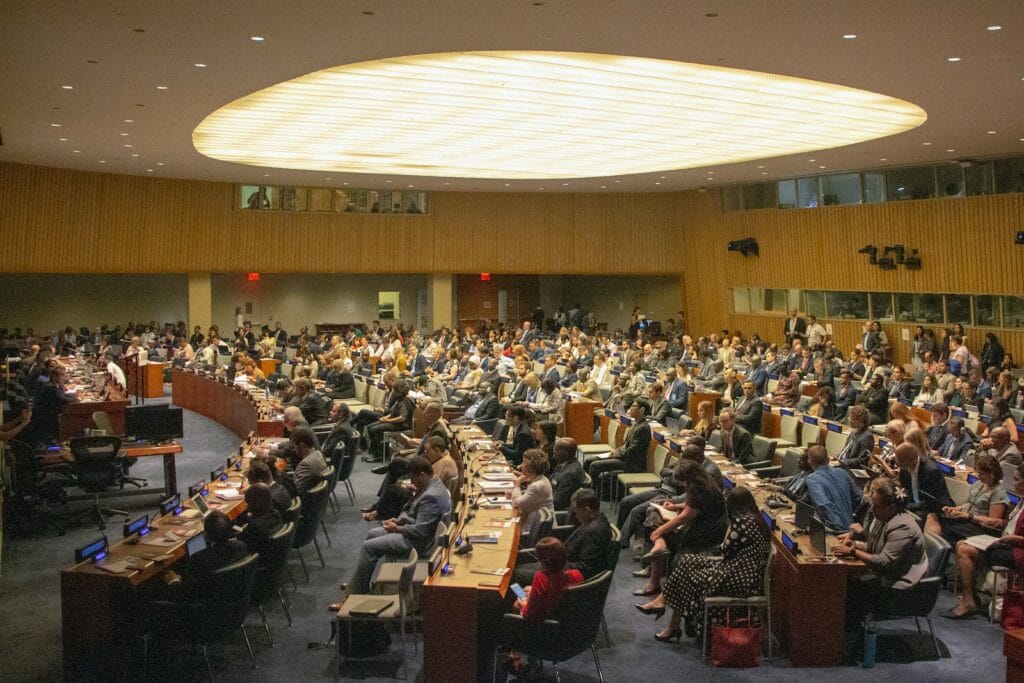Businesses and the UN’s Sustainable Development Goals

As the world grapples with escalating environmental crises, social inequalities, and the imperative to build a more sustainable future, businesses find themselves at the crossroads of responsibility and profitability. “How are we supposed to measure the impact?” is one of the frequent questions business leaders are asking. Corporate social responsibility (CSR) has evolved from a buzzword to a business expectation, and the United Nations’ Sustainable Development Goals (SDGs) form a critical framework for companies worldwide.
The 17 interconnected goals are a universal call to action to end poverty, protect the planet, and ensure prosperity for all by 2030. For businesses, the SDGs represent more than just a moral compass; they offer tangible advantages, from enhancing brand reputation to accessing new markets. Integrating sustainability into core business operations is not without its challenges. In this article, we will explore how the SDGs affect businesses and why they often struggle with sustainability.

How do SDGs affect businesses?
The SDGs provide a clear roadmap for businesses to align their strategies and goals with global sustainability priorities. By identifying which goals are most relevant to their industry and operations, companies can create actionable plans that contribute to the achievement of these goals. This alignment can drive innovation, promote responsible business practices, and ultimately enhance long-term profitability.
Communication and Reporting
The SDGs offer a universal language for businesses to communicate their sustainability efforts to stakeholders. Transparent reporting on progress toward SDG-related targets can foster trust among consumers, investors, and regulators. It also enables companies to differentiate themselves in a crowded marketplace by demonstrating a commitment to making a positive impact on society and the environment.
Capitalising on Benefits
Engaging with the SDGs can open up new business opportunities. Sustainable practices often lead to cost savings through reduced resource consumption and improved operational efficiency. Moreover, businesses that align with the SDGs can access a growing market of socially conscious consumers and investors, helping them stay competitive in an evolving global landscape.

Why do businesses struggle with the UN’s Sustainable Development Goals?
Sustainability still does not fit neatly into the traditional business case for many companies. While the benefits are clear, quantifying the return on investment and integrating sustainability seamlessly into business operations can be challenging. Businesses need to develop more robust methodologies for assessing and communicating the financial benefits of sustainability.
While the benefits of embracing the SDGs are clear, businesses often face significant challenges when integrating sustainability into their core operations. Here are some of the key obstacles:
Government Policies and Incentives
To accelerate progress towards the SDGs, governments need to enact policies that incentivize sustainable practices. Clear regulatory frameworks and financial incentives can encourage businesses to invest in sustainability initiatives. Without these measures, some companies may prioritise short-term profits over long-term sustainability.
Consumer Behaviour
Consumer attitudes toward sustainability vary widely, and not all consumers consistently factor sustainability into their purchase decisions. Businesses often struggle to strike a balance between meeting consumer demands for affordability and sustainability. To address this challenge, companies must educate consumers about the environmental and social impact of their products and services.
Employee Engagement
Motivating employees to actively participate in sustainability initiatives can be a daunting task. Many businesses find it challenging to foster a culture of sustainability and ensure that employees are not only aware of but also committed to the company’s sustainability goals. Employee education, involvement, and recognition are crucial to overcoming this hurdle.
The UN’s Sustainable Development Goals offer businesses a unique opportunity to align their strategies with global sustainability priorities, communicate their efforts transparently, and capitalise on the benefits of responsible business practices.
Challenges persist, including the need for supportive government policies, consumer education, and employee engagement. As businesses continue to grapple with these issues, the path to sustainability will require innovation, collaboration, and unwavering commitment. Embracing the SDGs is not only a moral imperative but also a strategic advantage in a world increasingly focused on creating a more sustainable and equitable future.
Too Many Metrics, Too Much Confusion
One of the persistent challenges in the sustainability landscape is the plethora of metrics and frameworks available for measuring sustainability. These diverse standards can be overwhelming for businesses. Companies often struggle to choose the most relevant metrics and align them with their sustainability goals. Simplifying the metrics landscape and creating industry-specific benchmarks would go a long way in providing clarity and consistency.
Government Policies and Incentives
While we touched on this earlier, the disconnect between government policies and sustainability goals deserves further attention. For businesses, government policies should incentivize sustainable practices while providing clear guidance and regulations. A more direct alignment between governmental actions and sustainability objectives is essential to accelerate progress.
Employee Motivation
Getting employees actively involved in sustainability initiatives remains a significant hurdle. Companies often grapple with the best approaches to motivate and engage their workforce in sustainability efforts. Employee education, participation, and recognition are vital components in overcoming this obstacle.
Identifying Key Opportunities and Threats
Discerning the most critical sustainability opportunities and threats on the horizon is a complex task. Many organizations struggle to prioritize their sustainability efforts effectively, often due to a lack of clarity about which issues are most pressing. Developing sophisticated risk assessment and scenario planning tools is essential to navigate this challenge.
Credible Communication and Avoiding Greenwashing
Companies that genuinely engage in sustainable practices may find it difficult to communicate their efforts credibly to consumers and stakeholders. Avoiding the perception of “greenwashing” is crucial. Improved transparency and reporting, along with third-party verification, can help build trust and credibility in sustainability initiatives.
Engaging Key Stakeholders
Engaging with key stakeholders, such as indigenous communities, can be complex. Better guidelines and protocols are needed to ensure respectful and inclusive collaboration, recognizing the unique perspectives and needs of different groups.
Lack of Common Rules for Sustainable Sourcing
The absence of universally accepted rules and standards for sustainable sourcing complicates matters for businesses. A common framework would help companies navigate global supply chains more effectively while ensuring their sourcing practices align with sustainability goals.
Risk of Leading the Sustainability Frontier
Lastly, companies that boldly pioneer the sustainability frontier sometimes face unforeseen challenges. These early adopters often take on risks that others can learn from. Balancing innovation with risk management is essential for those at the forefront of sustainability efforts.
The road to business sustainability in 2023 is fraught with hurdles. Overcoming these challenges will require collaboration, innovation, and a commitment to continuous improvement. As the world’s focus on sustainability intensifies, businesses must rise to the occasion, addressing these hurdles head-on to achieve a more sustainable and prosperous future for all.
Easy Steps for businesses to align their strategy with the UN’s Sustainable Development Goals framework
The market is brimming with contracting opportunities in international development projects, all backed by Multilateral Development Banks, aid agencies, government organizations, other International Financial Institutions, and select United Nations entities. Why do businesses struggle with sustainability?
Aligning business strategy with the United Nations’ Sustainable Development Goals (SDGs) is not only a moral imperative but also a strategic opportunity for companies to create long-term value and positive impact. Here are steps and considerations for businesses to effectively integrate the SDG framework into their strategy:
Understand the SDGs: Start by familiarising yourself with the 17 SDGs and their associated targets. Understand the key themes, such as poverty reduction, climate action, gender equality, and responsible consumption and production.
Identify Relevant Goals: Determine which SDGs are most relevant to your industry, operations, and stakeholders. Not all goals will be equally applicable to every business, so focus on those that align with your core activities and impact areas.
Set Clear Objectives: Define specific, measurable, and time-bound objectives related to the chosen SDGs. These objectives should reflect how your business can contribute to the achievement of these goals. Consider both short-term and long-term goals.
Conduct a Materiality Assessment: Identify the environmental, social, and governance (ESG) issues that are most material to your business and stakeholders. This assessment will help you prioritize sustainability efforts and align them with the SDGs.
Integrate Sustainability into Core Operations: Embed sustainability considerations into your core business processes, including product development, supply chain management, and employee practices. Ensure that sustainability becomes a fundamental part of your day-to-day operations.
Engage Stakeholders: Collaborate with key stakeholders, including employees, customers, suppliers, and investors, to gain insights into their expectations and concerns related to sustainability. Their input can help refine your approach.
Develop a Sustainability Roadmap: Create a comprehensive sustainability roadmap that outlines the specific initiatives, actions, and projects required to achieve your SDG-related objectives. This roadmap should include timelines, responsible parties, and resource allocations.
Measure and Report Progress: Implement robust monitoring and reporting systems to track progress towards your SDG-related goals. Use key performance indicators (KPIs) and metrics to quantify the impact of your sustainability initiatives. Regularly communicate your progress to stakeholders.
Collaborate and Partner: Seek opportunities for collaboration with other businesses, NGOs, governments, and academia to amplify your impact. Collaborative efforts can lead to innovative solutions and broader reach.
Innovate and Adapt: – Foster a culture of innovation within your organization to identify new ways of addressing sustainability challenges. Be prepared to adapt your strategy in response to evolving societal and environmental trends.
Align with Global Initiatives: – Participate in global sustainability initiatives and platforms that support the SDGs, such as the UN Global Compact or industry-specific sustainability coalitions. These platforms provide resources, guidance, and opportunities for collective action.
Responsible Procurement and Supply Chain Management: – Ensure that your procurement and supply chain practices align with sustainable sourcing and production principles. Encourage your suppliers to adopt responsible practices that contribute to the SDGs.
Engage Employees: – Motivate and educate your employees about the company’s sustainability goals and how they can contribute. Encourage employee involvement in sustainability initiatives, and recognize and reward their efforts.
By following these steps and continually assessing and adapting your strategy, businesses can effectively align themselves with the SDG framework, driving positive change while simultaneously enhancing their reputation, resilience, and competitiveness in an increasingly sustainability-conscious world.





